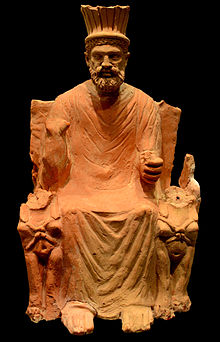Baal Hammon
| Baʿal Hammon | |
|---|---|
 Statue of Baʿal Hammon on his throne with a crown and flanked by sphinxes, 1st century. | |
| Consort | Tanit |
| Equivalents | |
| Greek | Cronus |
| Roman | Saturn |
Baal Hammon, properly Baʿal Hammon or Hamon (Punic: lbʻl ḥmn),[1] was the chief god of Carthage. He was a weather god considered responsible for the fertility of vegetation and esteemed as King of the Gods. He was depicted as a bearded older man with curling ram's horns.[2] Baʿal Hammon's female cult partner was Tanit.[3]
Cult and attributes
The worship of Baʿal Hammon flourished in the Phoenician colony of Carthage. His supremacy among the Carthaginian gods is believed to date to the fifth century BC, after relations between Carthage and Tyre were broken off at the time of the Battle of Himera (480 BC).[4] Modern scholars identify him variously with the Northwest Semitic god El or with Dagon.[citation needed]
In Carthage and North Africa Baʿal Hammon was especially associated with the ram and was worshiped also as Baʿal Qarnaim ("Lord of Two Horns") in an open-air sanctuary at Jebel Boukornine ("the two-horned hill") across the bay from Carthage, in Tunisia.[citation needed] He was probably never identified with Baʿal Melqart, although one finds this equation in older scholarship.[citation needed]
The interpretatio graeca identified him with the Titan Cronus. In ancient Rome, he was identified with Saturn, and the cultural exchange between Rome and Carthage as a result of the Second Punic War may have influenced the development of the festival of Saturnalia.[5]
Greco-Roman sources report that the Carthaginians burned their children as offerings to Baʿal Hammon. (See "Moloch" for a discussion of these traditions and conflicting thoughts on the matter.) Attributes of his Romanized form as an African Saturn indicate that Hammon (Amunus in Philo's work) was a fertility god.[6]
Name and functions

The meaning of "Hammon" is unclear. In the 19th century, when Ernest Renan excavated the ruins of Hammon (Ḥammon), the modern Umm al-‘Awamid between Tyre and Acre, he found two Phoenician inscriptions dedicated to El-Hammon. Since El was normally identified with Cronus and Ba‘al Hammon was also identified with Cronus, it seemed possible they could be equated. More often a connection with NW Semitic ḥammān ("brazier") has been proposed, suggesting the sense "Lord of the Brazier". He has been therefore identified with a solar deity.[7] Yigael Yadin thought him to be a moon god. Edward Lipinski identifies him with the god Dagon.[8]
Frank Moore Cross argued for a connection to Khamōn, the Ugaritic and Akkadian name for Mount Amanus, the great mountain separating Syria from Cilicia based on the occurrence of an Ugaritic description of El as the one of the Mountain Haman.[citation needed]
Location
Ba'al Hamon, Hammon, Khamon, or Ammon was a place mentioned in the Song of Solomon.[9] It was the location of a productive vineyard owned by Solomon, who let out the vineyard to tenants, each of whom was to bring him a thousand silver shekels. The locale has been supposed to be identical with Baal-gad, and also with Hammon in the tribe of Asher.[10] Others identify it with Belamon, in Central Israel, near Dothaim. Some have suggested that it is not to be taken as a literal place, but a figurative indication to the wealthy realm over which Solomon ruled.[citation needed]
See also
References
- ^ Дьяконов И. М. Языки древней Передней Азии. Издательство Наука, Москва. 1967.
- ^ Brouillet, Monique Seefried, ed. From Hannibal to Saint Augustine: Ancient Art of North Africa from the Musee du Louvre. Michael C. Carlos Museum, Emory University: Atlanta GA, 1994.
- ^ Carthage, a history, Serge Lancel, p195
- ^ Moscati, Sabatino (2001). The Phoenicians. Tauris, p. 132. ISBN 1-85043-533-2
- ^ Robert E.A. Palmer, Rome and Carthage at Peace (Franz Steiner, 1997), pp. 63–64.
- ^ Carthage, a history, Serge Lancel, p197
- ^ Walbank, Frank William (1979). A historical commentary on Polybius, Volume 2, Clarendon Press, p. 47
- ^ Edward Lipinski, Dictionnaire de la civilisation phenicienne et punique (1992: ISBN 2-503-50033-1).
- ^ Song of Solomon 8:11.
- ^ Joshua 19:28
External links
- Easton's Bible Dictionary 1897
- On-line parallel Bible: Song of Solomon 8:11
